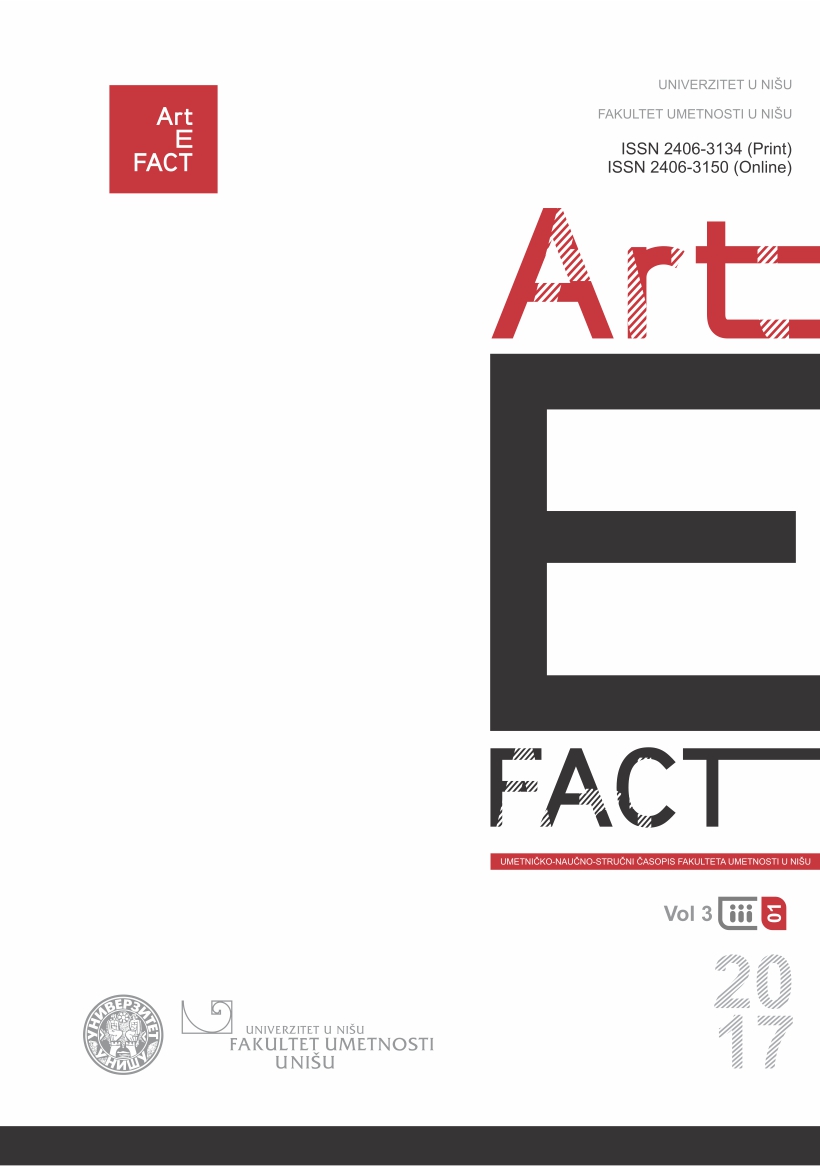Rhymes in the development of rhythmic and speaking skills of preschool and early school age
Abstract
The paper discusses the concept, definition and classification of nursery rhymes, and how they are processed. Rhymes are "short children's songs that serve to counting children at play, which at the same time can be very suitable for developing a sense of rhythm" (Pedagogical Lexicon, 1996, p. 56). There are several types of nursery rhymes and their classification according to different criteria. They can be classified according to form and content, as well as whether their authors are children or adults. The criterion of understanding classifies them into rhymes rational sense, irrational - meaningless, and rhymes with a partial sense (see examples of rhymes at Milenkovic and Dragojevic, 2009). According to an embodiment - the musical component rhymes are classified in the speaking which develops a sense of rhythm and sung, whose melodic movement of the highest in the fourth volume. Treatment begins with teaching nursery rhymes by ear, then the symbols represents the rhythm of nursery rhymes (phases with the adoption rhymes see at: Milenkovic and Dragojevic, 2009). In addition to this term in the literature can be found other names for the same name forms: counting, beads, classifying. There are many advantages that rhymes processing brings: the development of speech and speech creativity, encourage foreign language learning, developing communication skills, emotional and social maturation, encouraging cultural 'awareness, developing ethical and moral values, exploring the contents of nature and society. In selecting the nursery rhymes, it is necessary to pay attention to mental and physical development of children and to adjust the selected rhymes to their age. The paper presents the characteristics of rhythmic development and speaking skills of preschool and early school age. To this end are designed examples rhythmic rhymes and pointed to the need for interdisciplinary nature of the teaching subjects, and the correlation of teaching Serbian language, the Music Education / Music Culture and Physical Education. It is emphasized the role of educators / teachers, as well as the need for quality training of students in the study programs for the education of educators and teachers for the organization and implementation of focused activities that will develop the mentioned abilities in children.
References
Despić, D. (1997). Teorija muzike. Beograd: Zavod za udžbenike i nastavna sredstva.
Doyle, P. (1993). Fremdsprachenerziehung in der Grundschule. Zeitschrift fur Fremdsprachenforschung, 4(1), 48−90.
Enciklopedijski rječnik pedagogije. (1963). Zagreb: Matica hrvatska.
Ivanović, N. (2008). Participation musique - razvojna uloga muzike u obrazovanju. Inovacije u nastavi, 21(3), 69−74.
Nastavni plan i program za osnovno obrazovanje i vaspitanje. (2014). Istočno Sarajevo: Ministarstvo prosvjete i kulture − Republički pedagoški zavod − Zavod za udžbenike i nastavna sredstva. Preuzeto sa http://www.rpz-rs.org 2016 Oct 27.
Milenković, S. (2006). Metodika razvoja govora. Sremska Mitrovica: Viša škola za obrazovanje vaspitača.
Milenković, S. & Dragojević, B. (2009). Korelacija razvoja govora i muzičkog vaspitanja. Norma, 14(1), 103−110.
Milić, I. M. (2010). Motivacija učenika kao predispozicija uspešne nastave muzičke kulture učenika mlađih razreda osnovne škole. Uzdanica, 7(1), 163−171.
Milijević, S. (2015). Brojalice u funkciji razvoja govora i govornog izražavanja. Naša škola, časopis za teoriju i praksu vaspitanja i obrazovanja, 76(1), 37−53.
Pedagoški leksikon. (1996). Beograd: Zavod za udžbenike i nastavna sredstva.
Proleksis enciklopedija − prva hrvatska opća i nacionalna online enciklopedija. (2013). Zagreb: Leksikografski zavod Miroslav Krleža. Preuzeto sa http://proleksis.lzmk.hr/ 2016 Oct 10.
Ratković, D. (2011). Primjena instrumenata u prvoj trijadi osnovne škole. Riječ prosvjete, 1, 137−152.
Silić, A. (2007). Stvaranje poticajnoga okruženja u dječjemu vrtiću za komunikaciju na stranome jeziku. Odgojne znanosti, 9(2), 67−84.
Spasojević, P., Pribišev-Beleslin, T. & Nikolić, S. (2007). Program predškolskog vaspitanja i obrazovanja. Istočno Sarajevo: Zavod za udžbenike i nastavna sredstva. Preuzeto sa http://www.rpz-rs.org/sajt/doc/file/web_portal/05/5.1/Program%20predskolskog%20vaspitanja%20i%20obrazovanja.pdf 2016 Nov 4.
Vasiljević, Z. M. (2000). Metodika muzičke pismenosti. Beograd: Univerzitet umetnosti.
Velički, D. (2006). Ritam i pokret u ranom učenju njemačkog jezika. Metodika − časopis za teoriju i praksu metodikâ u predškolskom odgoju, školskoj i visokoškolskoj izobrazbi, 7(13), 327−335. Preuzeto sa http://hrcak.srce.hr/26968 2016 Oct 10.
Velički, V. (2009). Poticanje govora u kontekstu zadovoljenja dječjih potreba u suvremenom dječjem vrtiću. Metodika − časopis za teoriju i praksu metodikâ u predškolskom odgoju, školskoj i visokoškolskoj izobrazbi, 10(18), 80−91. Preuzeto sa http://hrcak.srce.hr/40817 2016 Oct 12.
Wilson, F. R. (1998). The Hand. How Its Use Shapes the Brain, Language and Human Culture. New York: Vintage Books.
Artefact omogućava otvoreni pristup i, u skladu sa preporukom CEON-a, primenjuje Creative Commons (CC BY) odredbe o autorskim pravima:
Autori koji objavlјuju u Artefact-u pristaju na sledeće uslove:
a) Autori zadržavaju autorska prava i pružaju časopisu pravo prvog objavlјivanja rada i licenciraju ga Creative Commons licencom koja omogućava drugima da dele rad uz uslov navođenja autorstva i izvornog objavlјivanja u ovom časopisu.
b) Autori mogu izraditi zasebne, ugovorne aranžmane za neekskluzivnu distribuciju rada objavlјenog u časopisu (npr. postavlјanje u institucionalni repozitorijum ili objavlјivanje u knjizi), uz navođenje da je rad izvorno objavlјen u ovom časopisu.
c) Autorima je dozvolјeno i podstiču se da postave objavlјeni rad onlajn (npr. u institucionalnom repozitorijumu ili na svojim internet stranicama) pre i tokom postupka prijave priloga, s obzirom da takav postupak može voditi produktivnoj razmeni ideja i ranijoj i većoj citiranosti objavlјenog rada (up. Efekat otvorenog pristupa).

